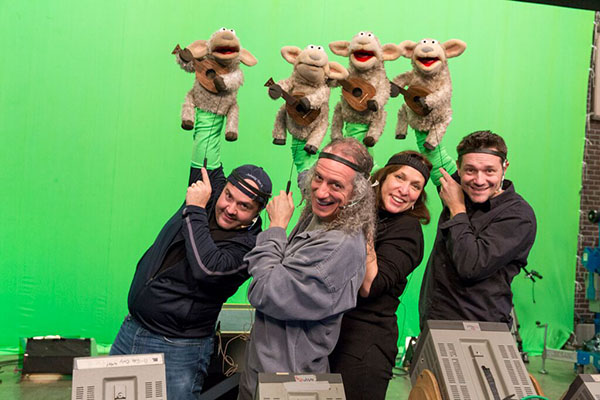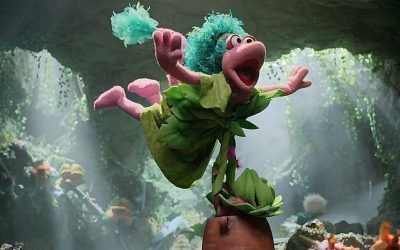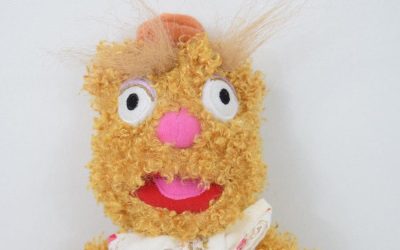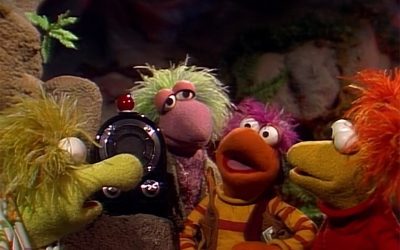Part 1 – Part 2
Before we get into our interview with Muppet performer John Kennedy, we have a special presentation. John’s band, the aptly-named Johnny K Band, has a brand new music video for their song, “Butterfly Springs” to share with us. The album, “Walk the Loop” is available on Amazon, Spotify, and CD Baby.
We hope you enjoyed this brand new video! Stay tuned for more about The Johnny K Band in part 2 of our interview with John Kennedy!
ToughPigs: John, thank you so much for joining us for this interview!
John Kennedy: Hey, no problem. Great to talk to you.
TP: Likewise. So, you are kind of known – at least around the Sesame Street parts – as the unsung hero of Sesame Street. Did you know that?
JK: I know a do a lot of things behind the scenes. They call me a “utility puppeteer,” which means I could be doing anything at any moment.
TP: Yes, and I do want to talk more about what you do for Sesame and what you’ve done for the Muppets, but I think we should probably start at the beginning. I’m curious how you got started as a puppeteer?
JK: Well, I started when I was three. I saw Sesame Street and I said, “I know what they’re doing, and I’m going to do that!”
TP: Easy enough.
JK: It was that simple. [laughter]
TP: So, I understand you started building puppets as a child, right?
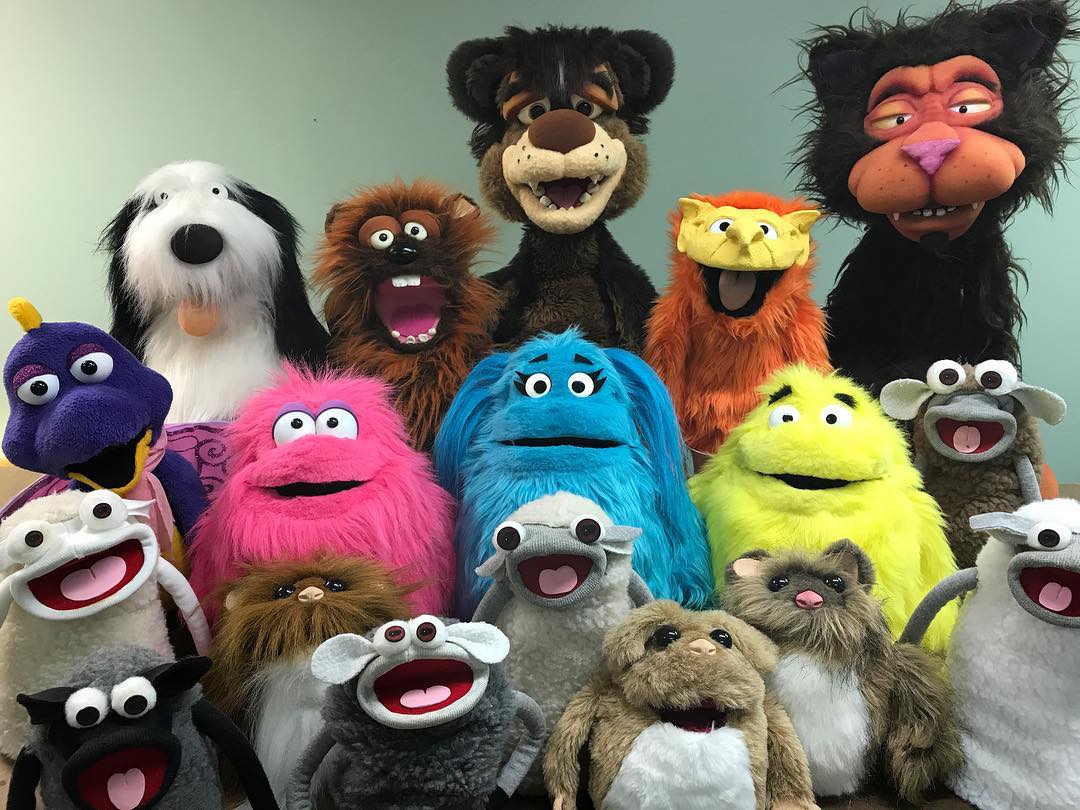 JK: I did, at that point I started creating my own characters. Luckily, my mom had a fabric bag and a sewing machine, so even when I was three, even though she wouldn’t let me use the sewing machine, I was stapling fabric together. I would be next to her while she was sewing something, and I’d be taking pieces out of the fabric scrap bag. “Can I have this? Can I have this? Can I have this button?” I tried to make my own little frog puppet way back then.
JK: I did, at that point I started creating my own characters. Luckily, my mom had a fabric bag and a sewing machine, so even when I was three, even though she wouldn’t let me use the sewing machine, I was stapling fabric together. I would be next to her while she was sewing something, and I’d be taking pieces out of the fabric scrap bag. “Can I have this? Can I have this? Can I have this button?” I tried to make my own little frog puppet way back then.
TP: Do you still have any of those old puppets you made when you were a kid?
JK: Well, I started collecting them when I turned seven. I made a foam sculpture puppet – I had moved on from fabric by 1974 – I was carving foam, I was trying to figure out how they smooth out the foam.
TP: And did you ever figure it out?
JK: I did, I figured it out in 1992. I figured out a way to do it myself. Once I started working with the Muppets, I learned how they did it, but I have my own method and I still use that method. I teach people, workshops, and things how to smooth it out with my patented method.
TP: And I guess if anyone wants to know how to do that, they can come take one of your workshops. We won’t reveal all your secrets here.
JK: Okay. [laughter]
TP: How did you get started with the Muppets?
JK: My uncle was art director for Dover Publishing in New York, and so I knew I could always come to New York and somehow get in with the Muppets, but I didn’t know how. I met a person through the Puppetry Guild in Indiana – that’s where I grew up, Plainfield, Indiana – so it was a long ways to New York. I went to the Puppetry Guild and I met someone I’m still friends with today, Brick Bell. He works at Disney. He showed me the number to the Muppets. This was around 1986. So I called the number and asked how do I get in, are there auditions, and they said, “Yeah, well, you’ve got to send in a tape.”
 I immediately began working on a videotape of my work, and luckily around that time I had gotten a job at the Indianapolis Union Station Festival Market Place (which I believe is no longer there), but at that time, 1986, this was the biggest thing to happen to Indianapolis, it was huge. I auditioned as a singing, dancing, banjo-playing puppeteer In wanting to work with puppets and the Muppets eventually, I sort of did my own program during school. In elementary school, I did birthday parties. In high school and junior high, I hosted the talent shows at school and my really nice teacher, Mrs. Warner, she let me host the shows with my best friend, Ed Lucas.
I immediately began working on a videotape of my work, and luckily around that time I had gotten a job at the Indianapolis Union Station Festival Market Place (which I believe is no longer there), but at that time, 1986, this was the biggest thing to happen to Indianapolis, it was huge. I auditioned as a singing, dancing, banjo-playing puppeteer In wanting to work with puppets and the Muppets eventually, I sort of did my own program during school. In elementary school, I did birthday parties. In high school and junior high, I hosted the talent shows at school and my really nice teacher, Mrs. Warner, she let me host the shows with my best friend, Ed Lucas.
This whole big build up to 1986 – all these characters I built, I’d put videos together, I had my own little business going, I was doing industrials with the company in Indianapolis, and working at the Indianapolis Repertory Theatre and the Indianapolis Symphony Orchestra… I mean, I was going big even in Indiana if I didn’t make it to the Muppets, but I was still gonna try. So I got the number from Brick Bell, I call it, I put my video together, I send it, and Jane Henson’s assistant writes me back and says, “Jane enjoyed your puppets very much and that you’ve been doing this at an early age, and we’d like to welcome you to one of our workshops if you can get to New York.”
It wasn’t an audition, it was a workshop. They would sort of workshop you, you’d come in many times until you were up to a level that they might try you on something. That’s where they were going with it. So I got to go to New York – I believe it’s ‘87, I know I got the letter in ‘87, it may have been early ’88 that I actually went – but Kevin Clash was there, Marty Robinson, Jim Martin, and Jane Henson was leading it, so it was the most amazing thing. I didn’t get to meet Jim Henson at that workshop.
TP: Still, it’s like you were in a class with like a bunch of celebrities.
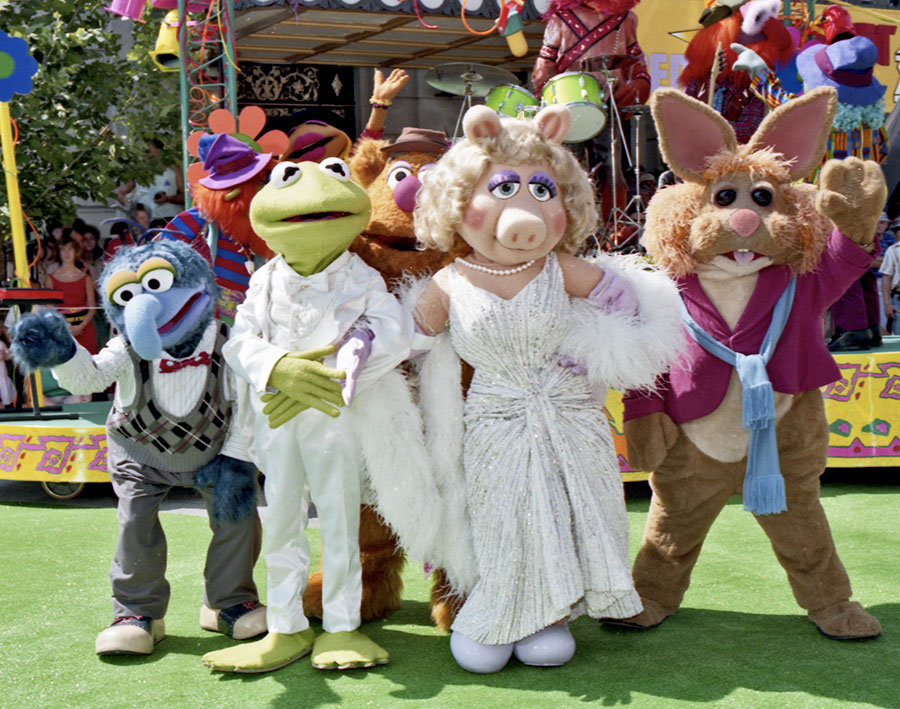 JK: I was! This was unbelievable to me to meet everybody that’s working with the Muppets! Here I got a puppet on my hand that was actually a Muppet. Maybe not one you’d know, but they had their rehearsal Muppets that we get to work with, and I bombed the first time. [laughs] In fact, I went back again the next year, and I met Joey Mazzarino, which it was his first workshop. We kept in touch, Joey and I became really good friends, and still are. So it got to be 1990 that I heard that the Muppets were going to Walt Disney World, and because I’d been to a couple of workshops, when I heard this news I called Henson up right away and said, “If I got to Orlando to be near the Muppets working there, would I get a job?” And the person there said, “We can’t guarantee that, but that would help.” Cause I’d gotten to that point where they were interested in me, but I lived in Indiana. Y’know, you become an assistant, and then you work up to getting characters and stuff, but as Jim Henson said, that takes five years once you start being a right hand. So I had to start my “right hand timeclock” somewhere.
JK: I was! This was unbelievable to me to meet everybody that’s working with the Muppets! Here I got a puppet on my hand that was actually a Muppet. Maybe not one you’d know, but they had their rehearsal Muppets that we get to work with, and I bombed the first time. [laughs] In fact, I went back again the next year, and I met Joey Mazzarino, which it was his first workshop. We kept in touch, Joey and I became really good friends, and still are. So it got to be 1990 that I heard that the Muppets were going to Walt Disney World, and because I’d been to a couple of workshops, when I heard this news I called Henson up right away and said, “If I got to Orlando to be near the Muppets working there, would I get a job?” And the person there said, “We can’t guarantee that, but that would help.” Cause I’d gotten to that point where they were interested in me, but I lived in Indiana. Y’know, you become an assistant, and then you work up to getting characters and stuff, but as Jim Henson said, that takes five years once you start being a right hand. So I had to start my “right hand timeclock” somewhere.
The weird thing was, and this was what seemed like fate happening, I immediately hung up the phone with Henson and called Disney, and said, “Hey, are there any jobs that I can do?” And they’re like, “Jobs? Well, what do you want to do?” I said, “Well, maybe something with characters or, y’know, I would sweep streets,” I just had to get there, I had to get a job and be in Orlando. And they said, “Well, we are having some character auditions in Indianapolis in a couple weeks.” And I’m like, “What!” And then I found out it was for the “Here Come the Muppets” show and they were looking for people who could move well. They wanted people that could dance, so I was like, “Wow! This is perfect!”
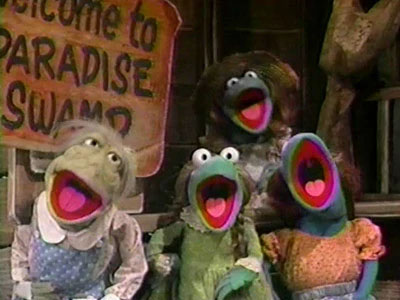 So I went in, I auditioned, I got the job, they relocated me to Orlando, and even before my first day of orientation with Disney, I went straight to where they were shooting Muppet stuff. They were on Stage 1 at Disney MGM Studios doing the big frog number. The song was “Knee Deep,” it was in the Muppets Walt Disney special. I walk in through these big double doors – it was just like something out of a movie – and there’s the big swamp scene and the big stage and all the Muppet people, there’s Jim Henson over in the corner doing a crossword puzzle and Jerry Nelson’s walking by with Robin hooked on his belt loop. [laughs] And there’s Kevin, and Kevin’s like, “It’s about time you got here!” It’s like this amazing day, and I was just so nervous. I couldn’t believe I was there. Plus, working at Disney World, I mean, that was a dream come true in itself, but then to be working with the Muppets, it was just … wow. Overwhelming.
So I went in, I auditioned, I got the job, they relocated me to Orlando, and even before my first day of orientation with Disney, I went straight to where they were shooting Muppet stuff. They were on Stage 1 at Disney MGM Studios doing the big frog number. The song was “Knee Deep,” it was in the Muppets Walt Disney special. I walk in through these big double doors – it was just like something out of a movie – and there’s the big swamp scene and the big stage and all the Muppet people, there’s Jim Henson over in the corner doing a crossword puzzle and Jerry Nelson’s walking by with Robin hooked on his belt loop. [laughs] And there’s Kevin, and Kevin’s like, “It’s about time you got here!” It’s like this amazing day, and I was just so nervous. I couldn’t believe I was there. Plus, working at Disney World, I mean, that was a dream come true in itself, but then to be working with the Muppets, it was just … wow. Overwhelming.
TP: So did you get to work on the Muppets at Walt Disney World special at all, or you were just visiting the set?
JK: I didn’t. You know, the disappointing thing was I’d been talking to them and they had said, “When you coming to Orlando?” on the phone. I didn’t realize when I wasn’t home one day they’d call, and my mom answered and they asked when I was coming cause they could really use me on the special. And she didn’t give me the note! She told me years later, “You know, they did call me once and say, ‘Could you come out sooner, you can work on the special.’ ” Oy!
TP: Thank god you got to work with the Muppets eventually, cause I think that would have been tragic.
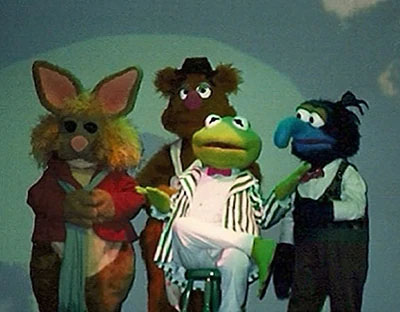 JK: I did. I did get to work with Jim Henson on the commercial for the show that I was in, the Here Come the Muppets show. So I did work with him for two days. He wanted me to send him a new video – I don’t think he’d seen the first one, but I’d done new stuff by then – he wanted to see that, so he said send it to New York. He told me about all the productions that were happening in Orlando, and, y’know, I got to be one of the Muppets in this commercial. I got to play, just in the background, utility guy stuff.
JK: I did. I did get to work with Jim Henson on the commercial for the show that I was in, the Here Come the Muppets show. So I did work with him for two days. He wanted me to send him a new video – I don’t think he’d seen the first one, but I’d done new stuff by then – he wanted to see that, so he said send it to New York. He told me about all the productions that were happening in Orlando, and, y’know, I got to be one of the Muppets in this commercial. I got to play, just in the background, utility guy stuff.
TP: You started your utility guy stuff early.
JK: Yeah, exactly. That’s kind of right hand work, that’s what you do. I became a specialty guy with stuff like juggling and throwing stuff. Leslie Carrara-Rudolph calls me “The King of Fling” cause they always put me in to throw something. I’m from Indiana, I play basketball, so I can hit it in the hoop. So that’s how I got to work with the Muppets.
TP: So, you got to work with Jim just before he passed, right?
JK: Yeah, last couple days of April I was there. I’ve got pictures of those couple of days of us working. It’s just… he was amazing. I got to see him and work with him. One of the first things I did was do Kermit’s right hand. I mean, it was just like, “What?” On the second day he had to leave, and he even said that Kermit had to go in and do one shot just in the background kind of thing, and he’s like, “Let Kennedy do it.” And that was the last thing I heard him say.
TP: Wow. That’s really special, that’s really incredible. So let’s move on and talk about – I’m gonna loop back around to Muppet stuff – but let’s talk about Sesame Street. Do you remember starting on Sesame and how that happened?
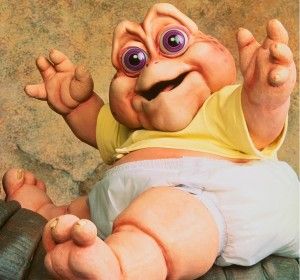 JK: Well the first thing I ever did was I started working on Dinosaurs, cause Joey Mazzarino had remembered me from the workshop and when he heard Kevin talking about this show in LA, he said, “You should go audition,” Joey said, “Well, you gotta ask John Kennedy too!” So he called me in Indiana, I had gone back from Florida to Indiana to visit my parents. I got a call at my parent’s house on New Year’s Eve from Joey saying, “You gotta come out! We’ll go out together! We’ll go audition for this show Dinosaurs!” [laughs]
JK: Well the first thing I ever did was I started working on Dinosaurs, cause Joey Mazzarino had remembered me from the workshop and when he heard Kevin talking about this show in LA, he said, “You should go audition,” Joey said, “Well, you gotta ask John Kennedy too!” So he called me in Indiana, I had gone back from Florida to Indiana to visit my parents. I got a call at my parent’s house on New Year’s Eve from Joey saying, “You gotta come out! We’ll go out together! We’ll go audition for this show Dinosaurs!” [laughs]
So that was a cool thing in itself, but being in LA and working closer with Kevin, cause I assisted Kevin with Baby Sinclair – I did the eyes of Baby Sinclair – and that was when Elmo was picking up. Big momentum of Elmo was becoming this huge phenomenon. So he brought me in to do one little imagination video where there’s like a thousand Elmo’s everywhere, and Elmo gets to juggle, and I did the juggling for Elmo. I was starting to become that guy that could do all those tricky things. I’ve worked with Bill Barretta and the Swedish Chef, and had the Chef juggle chalk eggs, y’know, things like that over my head with looking in a monitor – well, I guess live for that moment – those are just one of those skills I had to pick up thinking, “The Muppets might juggle, I better learn that.” So all those little, weird, tricky things have come in handy, and all the instruments I play. Y’know, whenever Kermit needs to play the banjo, sometimes I do that. It’s just a thing I enjoy doing.
But the very first time I worked on Sesame Street, other than that video, was 1994 after Dinosaurs was over. Kevin said, “Why don’t you come and I’ll see if I can get you in.” Basically you sit and you watch, and when there’s a spot that they need somebody else and everyone’s already assigned something, Kevin would say, “We need Johnny K!” So I’d run in and be a butterfly or something like that, so he was really nice to let me do that cause I’d been living in LA, and to make that jump to come to New York – I didn’t do it before, I didn’t go straight to New York and try to get in, I waited for the Orlando thing, but now it was inevitable I was going to have to move to New York.
 So, 1994, my first moment was helping Marty Robinson with Telly, cause I think Pam [Arciero] – I forget what she was doing, but she always does the right hand of Telly – she wasn’t there for some reason. It was my first day, and I was two hours late. (I’m surprised they didn’t just say, “You’re fired!”) It was right before lunch when I was supposed to come in, and I’d missed my bus, I was so nervous coming to Sesame Street and being a part of this. But I get there – it was for the 25th anniversary special, I think – and Telly’s supposed to talk to Joe Pesci on the phone. And at the time, Marty said, “This is the hardest thing Telly has had to do, so no pressure.”
So, 1994, my first moment was helping Marty Robinson with Telly, cause I think Pam [Arciero] – I forget what she was doing, but she always does the right hand of Telly – she wasn’t there for some reason. It was my first day, and I was two hours late. (I’m surprised they didn’t just say, “You’re fired!”) It was right before lunch when I was supposed to come in, and I’d missed my bus, I was so nervous coming to Sesame Street and being a part of this. But I get there – it was for the 25th anniversary special, I think – and Telly’s supposed to talk to Joe Pesci on the phone. And at the time, Marty said, “This is the hardest thing Telly has had to do, so no pressure.”
I had to get on one of those really low rolling things – I think they call it a Cadillac – it was big enough for two people to get on. It’s kind of a really low bed with wheels, basically what it looks like, so we had to go from one end of Sesame Street, near Oscar’s trash can, all the way around the street waving at people, going all the way over to the Fix-It Shop at that time, and we had to get in a phone booth, pull out a quarter, pick up the phone, put the money in, hit the numbers – y’know, phone booths are something you don’t see anymore – and he had to call Joe Pesci. There was a split screen and Joe Pesci’s on the other side – I think they were shooting it live that day he was there – and we had to hang up the phone after the conversation. As just a funny little thing, Marty wanted us to look for a quarter, to see if there was any money left over, looking in the little coin return. Just explaining it, it sounds complicated, but that’s just me talking. It went smoothly, we did it, it was great, but it was hard, really hard to do.
TP: I’m going to think of you next time I watch that special rolling across the street, all the choreography, making it look real. You say it doesn’t sound complicated, but to someone who’s not a puppeteer, like myself, that’s incredibly complicated. I don’t know if I’d be able to do that.
JK: Well, there’s just a lot of tricks you use, looking live, but you also have to make it look real on the monitor for what the camera’s seeing. So getting the monitor’s set where you need them and being able to maneuver easily first, but then also… It’s just two worlds, you’re thinking about – the dancer that I am – you think about how things move below the frame, but then what has to be believable is what’s above the frame and what’s on screen, on the monitor. You have to negotiate both worlds simultaneously and do whatever it takes. The screen has to win. Whatever you have to do down below, whatever, nobody’s going to see that. I’ve had to do things like, y’know, you end up rolling on the floor out of the frame or if your rollies, if the wheel fell off or something, you’ve got to save that shot.
TP: Right, film is expensive.
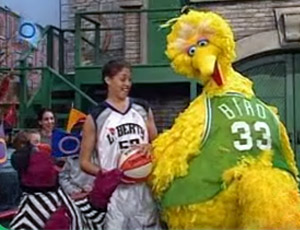 JK: I treated it kind of like how Larry Bird played basketball. He would just dive, whatever it took to keep that ball in play. He would catch his own shot and then dunk it in. (Well, he was great at shooting, he wasn’t so much a dunker.) Y’know, his skill level was so great. So I kinda, coming from Indiana, took that as inspiration and put that into my puppetry.
JK: I treated it kind of like how Larry Bird played basketball. He would just dive, whatever it took to keep that ball in play. He would catch his own shot and then dunk it in. (Well, he was great at shooting, he wasn’t so much a dunker.) Y’know, his skill level was so great. So I kinda, coming from Indiana, took that as inspiration and put that into my puppetry.
TP: You are the Larry Bird of Sesame Street! So do you have any favorite Sesame Street moments? Favorite episodes you worked on, characters you played, celebrities you worked with?
JK: Ryan Reynolds was really nice. He played a giant A.
TP: That’s a great episode. I love that one.
JK: Yeah, he’s really good in it. I played the hands of an ape doing a harp.
TP: I gotta tell you, of recent years, that scene with the ape singing his song about the letter A was one of the funniest things I think Sesame Street has done in years. I remember watching that for the first time and laughing my ass off.
JK: It was crazy! It was just funny, and while we’re doing it Ryan Reynold’s in this A costume’s head is just sticking through this little hole there. He’s talking to me – usually celebrities don’t talk to the person doing the right hand. They’ll talk to the characters, and it’s such a fun, light situation, of course, celebrities love working with the Muppets and we love working with celebrities. But, y’know, I’m the assistant guy, why would you talk to me? The guy doing the ape would be the one you’d talk to. But he was super nice to me.
TP: That’s good to know. I always hoped that Ryan Reynolds would be a nice guy.
JK: Yeah, so that’s one that stands out. I mean, there’s been a lot… Gosh, there’s just too many stories to tell.
Yes, there are more stories to tell! Stay tuned for part 2 of our interview with Muppet performer John Kennedy this week!
Click here to perform the right hand of the ToughPigs forum!
by Joe Hennes – Joe@ToughPigs.com

